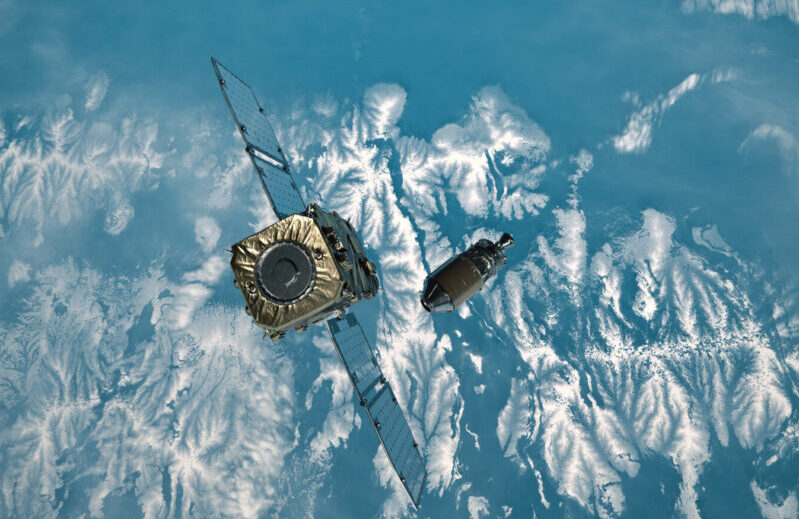
Enlarge / This artist’s illustration released by Astroscale shows the ADRAS-J spacecraft (left) approaching the defunct upper stage from a Japanese H-IIA rocket.
Astroscale, a well-capitalized Japanese startup, is preparing a small satellite to do something that has never been done in space.
This new spacecraft, delivered into orbit Sunday by Rocket Lab, will approach a defunct upper stage from a Japanese H-IIA rocket that has been circling Earth for more than 15 years. Over the next few months, the satellite will try to move within arm’s reach of the rocket, taking pictures and performing complicated maneuvers to move around the bus-size H-IIA upper stage as it moves around the planet at nearly 5 miles per second (7.6 km/s).
These maneuvers are complex, but they’re nothing new for spacecraft visiting the International Space Station. Military satellites from the United States, Russia, and China also have capabilities for rendezvous and proximity operations (RPO), but as far as we know, these spacecraft have only maneuvered in ultra-close range around so-called “cooperative” objects designed to receive them.
The difference here is the H-IIA rocket is uncontrolled, likely spinning and in a slow tumble, and was never designed to accommodate any visitors. Japan left it in orbit in January 2009 following the launch of a climate monitoring satellite and didn’t look back.
That was the case, at least, until a few years ago, when the Japan Aerospace Exploration Agency (JAXA) partnered with Astroscale in a public-private partnership to demonstrate capabilities the private sector could use to eventually remove large pieces of space debris littering low-Earth orbit. The same robotic technologies could also apply to satellite servicing or refueling missions.
“We are putting this debris removal by robotic technology as one of our main technology development areas because safely approaching an object, and also observing the object and capturing the object, is basically a common technology for any on-orbit servicing,” said Eddie Kato, president and managing director of Astroscale Japan.
In hot pursuit
This mission is called ADRAS-J, short for Active Debris Removal by Astroscale-Japan. “This mission entails the first ever approach of actual space debris and will be a monumental step toward a more sustainable future in space,” Mike Lindsay, Astroscale’s chief technology officer, posted on X.
The ADRAS-J spacecraft, built in-house at Astroscale’s Tokyo headquarters, is about the size of a kitchen oven and weighs roughly 330 pounds (150 kilograms) fully fueled. The satellite launched from New Zealand at 9: 52 am EST (1452 UTC) Sunday aboard an Electron rocket provided by Rocket Lab. About an hour after liftoff, ADRAS-J deployed from the Electron’s kick stage into an on-target polar orbit reaching an altitude of 370 miles (600 kilometers) at its highest point.
The liftoff from Rocket Lab’s spaceport in New Zealand was timed to allow ADRAS-J to launch into the same orbital plane as its objective—the H-IIA upper stage. Astroscale reported the spacecraft was healthy after Sunday’s launch. In a pre-launch interview, Kato said ADRAS-J will begin its pursuit of the spent H-IIA rocket in a couple of weeks, once ground teams complete initial checkouts of the spacecraft.
ADRAS-J will fire thrusters to match orbits with the H-IIA rocket, and as soon as next month, it could be flying within about 300 feet (100 meters) of the abandoned upper stage. Astroscale engineers will initially rely on ground-based tracking data to pinpoint the H-IIA’s location in space. Once in closer range, ADRAS-J will use visible and infrared cameras, along with laser ranging sensors, to transition to relative navigation mode. These sensors will measure the distance, closing rate, and orientation of the upper stage.
Astroscale officials view the switch from relying on ground tracking data to onboard relative navigation sensors as a crucial moment for the ADRAS-J mission. ADRAS-J will circle the rocket to assess its spin rate, spin axis, and the condition of its structure. This is the crux of the challenge for ADRAS-J because the rocket is unpowered and therefore unable to hold position. The upper stage also lacks laser reflectors and targets that would aid an approaching spacecraft.
This will mark the conclusion of the JAXA-supported portion of the ADRAS-J mission. If everything is working as planned, the spacecraft could move closer to the rocket to further validate Astroscale’s sensor suite and automated navigation and guidance algorithms. This will allow the company’s engineers to gather data for a proposed follow-on mission to actually go up and grab onto the same H-IIA upper stage and remove it from orbit.
“We are targeting to go closer, maybe 1 to 2 meters away from the object. Why? Because the next mission will be to really capture the H-IIA launch vehicle,” Kato told Ars last week. “In order to safely approach to a range where a robotic arm is able to be extended, it’s probably like 1.5 to 2 meters away from the object. We want to demonstrate up to that point through this ADRAS-J mission. Then on the next mission, called ADRAS-J2, we are actually equipping the robotic arm and capturing the H-IIA launch vehicle.”